engine CITROEN RELAY 2019 Handbook (in English)
[x] Cancel search | Manufacturer: CITROEN, Model Year: 2019, Model line: RELAY, Model: CITROEN RELAY 2019Pages: 232, PDF Size: 8.21 MB
Page 101 of 232

99
Speed limiter
The system prevents the vehicle
from exceeding the speed setting
programmed by the driver.
Speed selection is made with the vehicle
stationary and the engine running or with
the vehicle moving and 2nd gear or higher
engaged.
The minimum speed that can be programmed
is 19
mph (30 km/h).
The vehicle responds to the driver's foot
pressure on the accelerator until resistance is
felt in the pedal, which signifies that the vehicle
has reached the programmed speed.
However, pressing the pedal beyond this point
of resistance to the floor permits exceeding
the programmed speed. To resume use of
the limiter, simply reduce the pressure on
the accelerator pedal gradually and return to
a
speed below the programmed speed. 1.
Selecting the limiter function.
2. Activation/deactivation of the function.
3. Programming a
speed.
The function selection status and the
programmed speed are displayed in the
instrument panel screen. The speed limiter is a
driving aid that
cannot, in any circumstances, replace the
need to obser ve speed limits or the need
for vigilance on the part of the driver.
Selecting the function
F Turn the ring fully downwards. The speed limiter is selected but
is not yet active.
The display indicates OFF and the last
programmed speed.
Programming a speed
A speed can be programmed without activating
the limiter but with the engine running.
To enter a
speed higher than the previous one:
F
M
ove the control up (+).
A short press increases the speed by 1
mph
(km/h).
Holding it increases the speed in steps of
5
mph (km/h).
To enter a
speed lower than the previous one:
F
M
ove the control down (-).
A short press decreases the speed by 1
mph
(km/h).
Holding it decreases the speed in steps of
5
mph (km/h).
6
Driving
Page 117 of 232

FILL UP WITH
CONFIDENCE
WITH TOTAL QUARTZ
LUBRICANTS
For more than 45 years, TOTAL
and CITROËN have shared common
values: excellence, creativity and
technological innovation.
It is in this same spirit that TOTAL has
developed a
range
of TOTAL QUARTZ
lubricants adapted to CITROËN
engines, making them even more
fuel efficient and protective of the
environment.
TOTAL and CITROËN test the
reliability and the performance of their
products during motorsport races in
extreme conditions.
Choose TOTAL QUARTZ
lubricants to maintain
your vehicle, this is your
assurance of optimum
durability and performance
from your engine.
Page 118 of 232
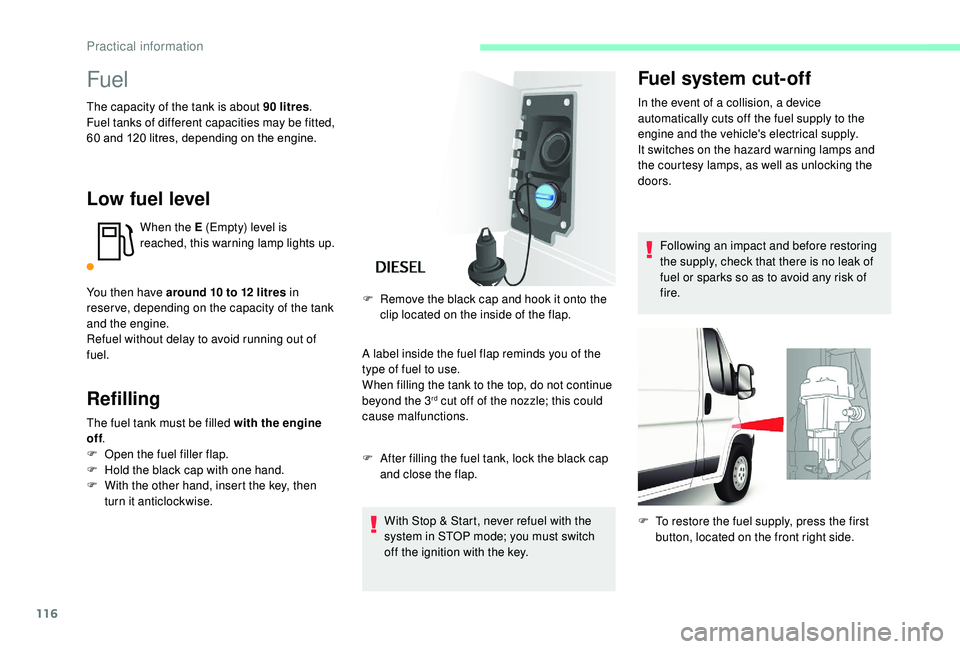
116
Fuel
The capacity of the tank is about 90 litres.
F uel tanks of different capacities may be fitted,
60
and 120 litres, depending on the engine.
Low fuel level
When the E (Empty) level is
reached, this warning lamp lights up.
You then have around 10
to 12 litres in
reser ve, depending on the capacity of the tank
and the engine.
Refuel without delay to avoid running out of
fuel.
Refilling
The fuel tank must be filled with the engine
off .
F
O
pen the fuel filler flap.
F
H
old the black cap with one hand.
F
W
ith the other hand, insert the key, then
turn it anticlockwise. A label inside the fuel flap reminds you of the
type of fuel to use.
When filling the tank to the top, do not continue
beyond the 3
rd cut off of the nozzle; this could
cause malfunctions.
F
A
fter filling the fuel tank, lock the black cap
and close the flap.
With Stop & Start, never refuel with the
system in STOP mode; you must switch
off the ignition with the key.
F
R
emove the black cap and hook it onto the
clip located on the inside of the flap.
Fuel system cut-off
In the event of a collision, a device
a utomatically cuts off the fuel supply to the
engine and the vehicle's electrical supply.
It switches on the hazard warning lamps and
the courtesy lamps, as well as unlocking the
doors.
Following an impact and before restoring
the supply, check that there is no leak of
fuel or sparks so as to avoid any risk of
fire.
F
T
o restore the fuel supply, press the first
button, located on the front right side.
Practical information
Page 120 of 232

118
Compatibility of fuels
Fuel used for Diesel
engines
The diesel engines are compatible with biofuels
that conform to current and future European
standards and which can be obtained from
filling stations.Diesel fuel that meets standard
EN590
mixed with a biofuel that
meets standard EN14214 (possibly
containing up to 7% Fatty Acid
Methyl Ester).
Diesel fuel that meets standard
EN16734
mixed with a biofuel that
meets standard EN14214 (possibly
containing up to 10% Fatty Acid
Methyl Ester).
Paraffinic Diesel fuel that meets
standard EN15940
mixed with
a
biofuel that meets standard
EN14214 (possibly containing up to
7% Fatty Acid Methyl Ester). For more information, contact a
CITROËN
dealer or a
qualified workshop.
The use of any other type of (bio)fuel
(vegetable or animal oils, pure or diluted,
domestic fuel…) is strictly prohibited (risk
of damage to the engine and fuel system).
The only Diesel additives authorised
for use are those that meet the
B715000
standard.
Diesel at low temperature
At temperatures below 0°C (+32°F), the
formation of paraffins in summer-type Diesel
fuels could entail an abnormal operation
of the fuel supply circuit. To avoid this, we
recommend using winter-type Diesel fuel and
keeping the fuel tank more than 50% full.
If, despite this, at temperatures below -15°C
(+5°F) the engine has problems starting,
just leave the vehicle in a garage or heated
workshop for a
little while.
The use of B20
or B30
fuel meeting
standard EN16709
is possible in
your Diesel engine. However, this
use, even occasional, requires strict
application of the special ser vicing
conditions referred to as "Arduous
conditions".
Travelling abroad
Cer tain fuels could damage the engine of
your vehicle.
In cer tain countries, the use of a
par ticular
fuel may be required (specific octane
rating, specific sales name, etc.) to ensure
correct operation of the engine.
For any additional information, contact a dealer.
Practical information
Page 127 of 232

125
Bonnet
Opening
Before doing anything under the bonnet,
deactivate the Stop & Start system to
avoid the risk of injury related to an
automatic change to START mode.
Inside
This operation must only be carried out with the
vehicle stationary and the driver's door open.
Outside
Do not open the bonnet in very windy
conditions.
When the engine is hot, handle the safety
catch and stay with care (risk of burns).Because of the presence of electrical
equipment under the bonnet, it is
recommended that exposure to water
(rain, washing, etc.) be limited.
Closing the bonnet
F Pull towards you the release lever located
on the side of the dashboard. F
P
ush up the safety catch located above the
grille and raise the bonnet. F
U
nclip the stay and tilt it to insert it in the
first notch, then the second.
F
B
efore closing the bonnet, put the stay back
in its housing.
F L ower the bonnet and release it at the end
of its travel. Check that the bonnet is locked.
7
Practical information
Page 128 of 232
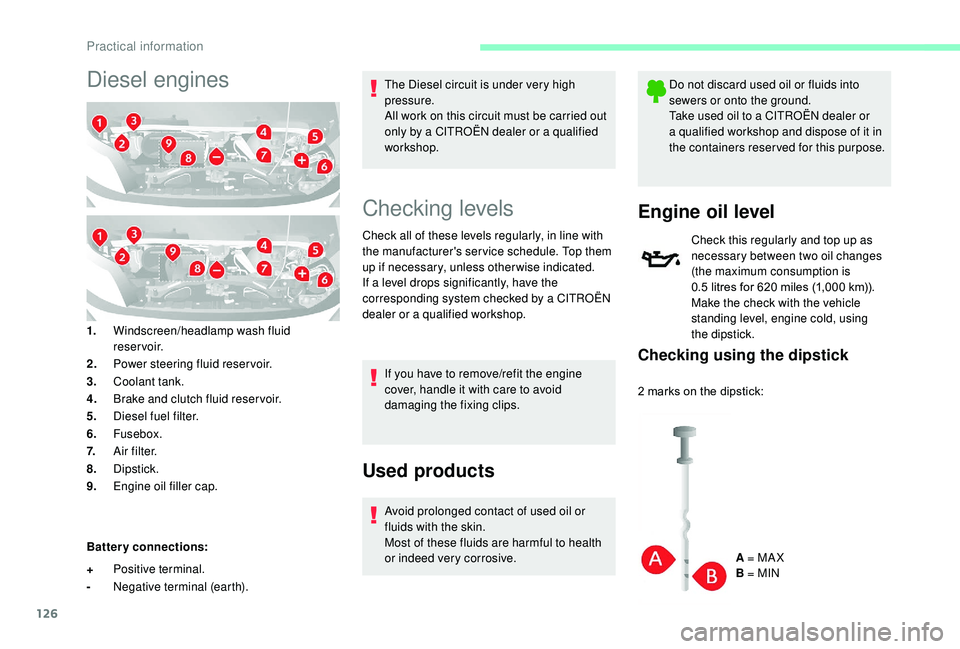
126
Diesel engines
1.Windscreen/headlamp wash fluid
reservoir.
2. Power steering fluid reservoir.
3. Coolant tank.
4. Brake and clutch fluid reser voir.
5. Diesel fuel filter.
6. Fusebox.
7. A i r f i l t e r.
8. Dipstick.
9. Engine oil filler cap.
Battery connections:
+ Positive terminal.
- Negative terminal (earth). The Diesel circuit is under very high
pressure.
All work on this circuit must be carried out
only by a
CITROËN dealer or a qualified
workshop.
Checking levels
Check all of these levels regularly, in line with
the manufacturer's service schedule. Top them
up if necessary, unless other wise indicated.
If a
level drops significantly, have the
corresponding system checked by a
CITROËN
dealer or a
qualified workshop.
If you have to remove/refit the engine
cover, handle it with care to avoid
damaging the fixing clips.
Used products
Avoid prolonged contact of used oil or
fluids with the skin.
Most of these fluids are harmful to health
or indeed very corrosive. Do not discard used oil or fluids into
sewers or onto the ground.
Take used oil to a
CITROËN dealer or
a qualified workshop and dispose of it in
the containers reser ved for this purpose.
Engine oil level
Check this regularly and top up as
necessary between two oil changes
(the maximum consumption is
0.5
litres for 620 miles (1,000 km)).
Make the check with the vehicle
standing level, engine cold, using
the dipstick.
Checking using the dipstick
2 marks on the dipstick:
A = MA X
B = MIN
Practical information
Page 129 of 232
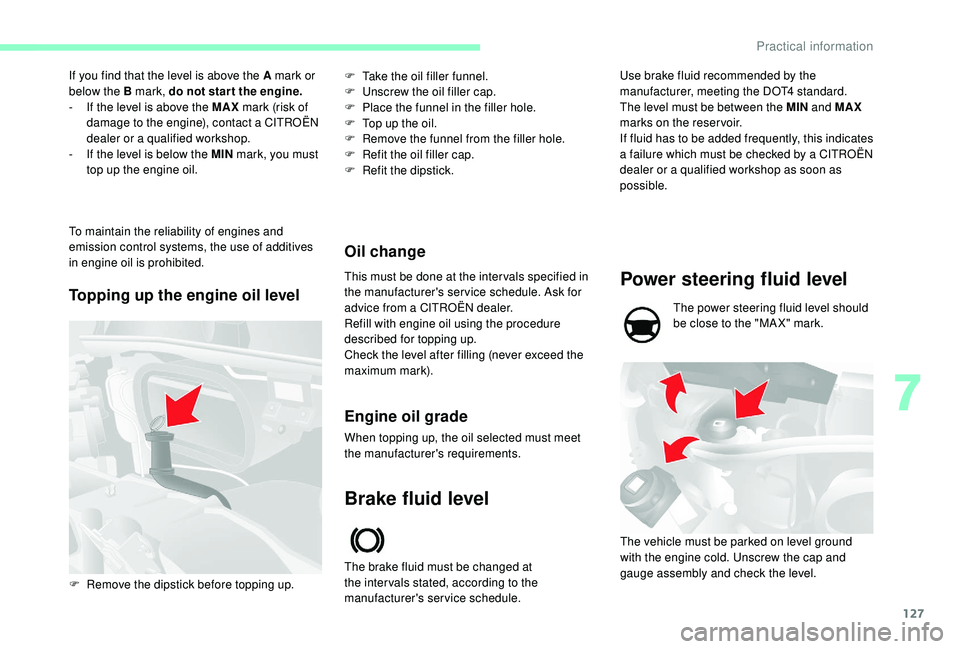
127
If you find that the level is above the A mark or
below the B mark, do not star t the engine.
-
I
f the level is above the MAX mark (risk of
damage to the engine), contact a
CITROËN
dealer or a
qualified workshop.
-
I
f the level is below the MIN mark, you must
top up the engine oil.
To maintain the reliability of engines and
emission control systems, the use of additives
in engine oil is prohibited.
Topping up the engine oil level Oil change
This must be done at the inter vals specified in
the manufacturer's service schedule. Ask for
advice from a
CITROËN dealer.
Refill with engine oil using the procedure
described for topping up.
Check the level after filling (never exceed the
maximum mark). F
T
ake the oil filler funnel.
F
U
nscrew the oil filler cap.
F
P
lace the funnel in the filler hole.
F
T
op up the oil.
F
R
emove the funnel from the filler hole.
F
R
efit the oil filler cap.
F
R
efit the dipstick.
F
R
emove the dipstick before topping up.
Engine oil grade
When topping up, the oil selected must meet
the manufacturer's requirements.
Brake fluid level
The brake fluid must be changed at
the inter vals stated, according to the
manufacturer's service schedule.
Power steering fluid level
The power steering fluid level should
be close to the "MA X" mark.
The vehicle must be parked on level ground
with the engine cold. Unscrew the cap and
gauge assembly and check the level.
Use brake fluid recommended by the
manufacturer, meeting the DOT4
standard.
The level must be between the MIN and MAX
marks on the reservoir.
If fluid has to be added frequently, this indicates
a
failure which must be checked by a CITROËN
dealer or a qualified workshop as soon as
possible.
7
Practical information
Page 130 of 232

128
For access to the reser voir filler cap, remove
the protective cover by turning its three fixing
screws a quarter turn, then remove the second
cover fitted to the cap.
Engine coolant level
Check the coolant level regularly.
It is normal to top up this fluid
between two services.
Check the coolant level regularly,
according to the use made of your vehicle
(every 3,000
miles (5,000 km)/3 months);
if necessary, top up using coolant
recommended by the manufacturer.
The check and top up must only be done
with the engine cold.
A low coolant level presents a
risk of
serious damage to your engine.
When the engine is hot, the temperature of the
coolant is regulated by the electric fan. This
may operate with the ignition off; furthermore,
because the cooling system is under pressure,
wait for at least one hour after the engine has
stopped before carrying out any work. F
F
or access to the header tank filler cap,
remove the protective cover by turning its
three fixing screws a quarter turn.
F
T
o avoid the risk of scalding, place a cloth
around the cap, then loosen the cap by
a
quarter turn to release the pressure.
F
W
hen the pressure has dropped, remove
the cap and top up the level with coolant.
To p p i n g u p
The level must be between the MIN and MAX
marks on the expansion bottle.
As close as possible to the MAX mark is
recommended.
If more than 1
litre of fluid is required to top
up the level, have the system checked by
a
CITROËN dealer or a qualified workshop.
Screenwash and headlamp
wash level
To check the level or top up the fluid
on vehicles fitted with headlamp
washers, immobilise the vehicle and
switch off the engine.
Capacity of the reservoir: approximately
5.5
litres.
F
F
or access to the reser voir filler cap, pull on
the telescopic filler pipe and unclip the cap.
Practical information
Page 131 of 232
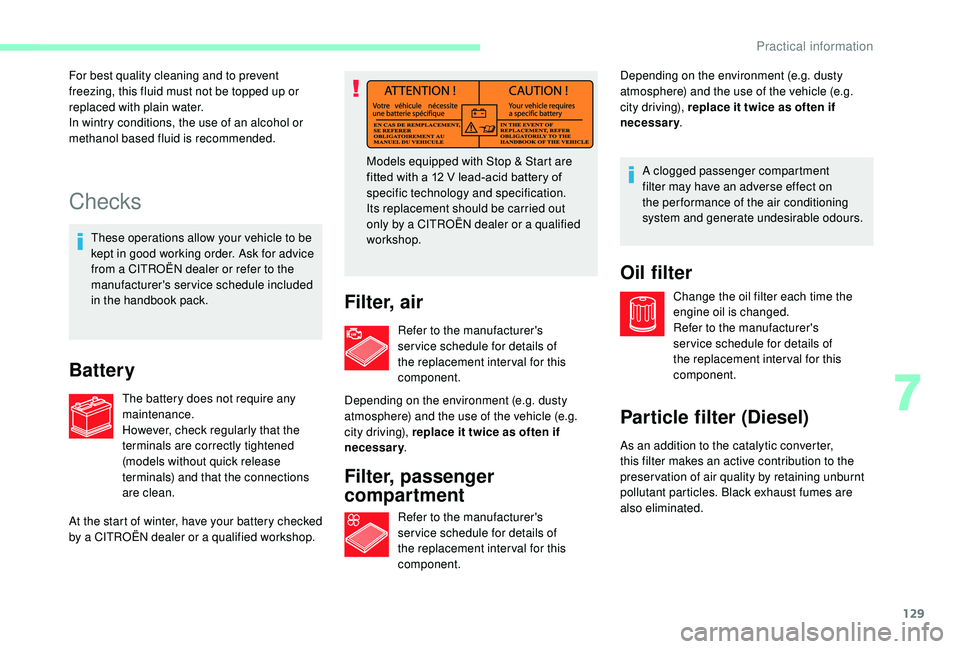
129
Checks
These operations allow your vehicle to be
kept in good working order. Ask for advice
from a CITROËN dealer or refer to the
manufacturer's service schedule included
in the handbook pack.
Battery
The battery does not require any
maintenance.
However, check regularly that the
terminals are correctly tightened
(models without quick release
terminals) and that the connections
are clean. Models equipped with Stop & Start are
fitted with a
12 V lead-acid battery of
specific technology and specification.
Its replacement should be carried out
only by a CITROËN dealer or a qualified
workshop.
Filter, air
At the start of winter, have your battery checked
by a CITROËN dealer or a qualified workshop.
For best quality cleaning and to prevent
freezing, this fluid must not be topped up or
replaced with plain water.
In wintry conditions, the use of an alcohol or
methanol based fluid is recommended.
Refer to the manufacturer's
ser vice schedule for details of
the replacement inter val for this
component.
Depending on the environment (e.g. dusty
atmosphere) and the use of the vehicle (e.g.
city driving), replace it twice as often if
necessary .
Filter, passenger
compartment
Refer to the manufacturer's
ser vice schedule for details of
the replacement inter val for this
component. Depending on the environment (e.g. dusty
atmosphere) and the use of the vehicle (e.g.
city driving), replace it twice as often if
necessary
.
Oil filter
Change the oil filter each time the
engine oil is changed.
Refer to the manufacturer's
ser vice schedule for details of
the replacement inter val for this
component.
Particle filter (Diesel)
A clogged passenger compartment
filter may have an adverse effect on
the per formance of the air conditioning
system and generate undesirable odours.
As an addition to the catalytic converter,
this filter makes an active contribution to the
preser vation of air quality by retaining unburnt
pollutant particles. Black exhaust fumes are
also eliminated.
7
Practical information
Page 132 of 232
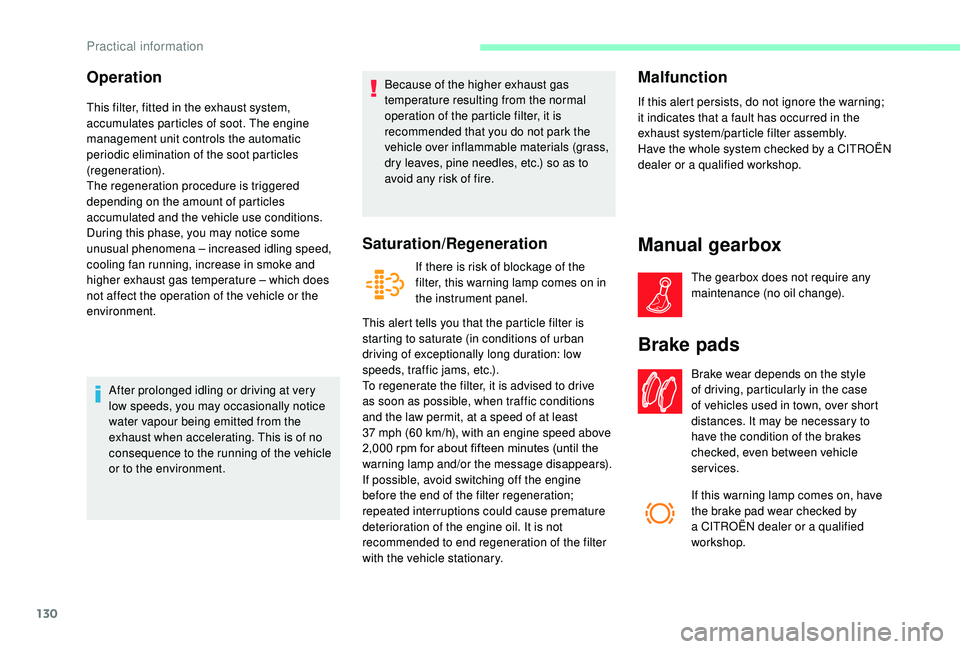
130
Operation
This filter, fitted in the exhaust system,
accumulates particles of soot. The engine
management unit controls the automatic
periodic elimination of the soot particles
(regeneration).
The regeneration procedure is triggered
depending on the amount of particles
accumulated and the vehicle use conditions.
During this phase, you may notice some
unusual phenomena – increased idling speed,
cooling fan running, increase in smoke and
higher exhaust gas temperature – which does
not affect the operation of the vehicle or the
environment.After prolonged idling or driving at very
low speeds, you may occasionally notice
water vapour being emitted from the
exhaust when accelerating. This is of no
consequence to the running of the vehicle
or to the environment. Because of the higher exhaust gas
temperature resulting from the normal
operation of the particle filter, it is
recommended that you do not park the
vehicle over inflammable materials (grass,
dry leaves, pine needles, etc.) so as to
avoid any risk of fire.
Saturation/Regeneration
If there is risk of blockage of the
filter, this warning lamp comes on in
the instrument panel.
This alert tells you that the particle filter is
starting to saturate (in conditions of urban
driving of exceptionally long duration: low
speeds, traffic jams, etc.).
To regenerate the filter, it is advised to drive
as soon as possible, when traffic conditions
and the law permit, at a
speed of at least
37
mph (60 km/h), with an engine speed above
2,000
rpm for about fifteen minutes (until the
warning lamp and/or the message disappears).
If possible, avoid switching off the engine
before the end of the filter regeneration;
repeated interruptions could cause premature
deterioration of the engine oil. It is not
recommended to end regeneration of the filter
with the vehicle stationary.
Malfunction
If this alert persists, do not ignore the warning;
it indicates that a fault has occurred in the
exhaust system/particle filter assembly.
Have the whole system checked by a
CITROËN
dealer or a
qualified workshop.
Manual gearbox
The gearbox does not require any
maintenance (no oil change).
Brake pads
Brake wear depends on the style
of driving, particularly in the case
of vehicles used in town, over short
distances. It may be necessary to
have the condition of the brakes
checked, even between vehicle
services.
If this warning lamp comes on, have
the brake pad wear checked by
a
CITROËN dealer or a qualified
workshop.
Practical information